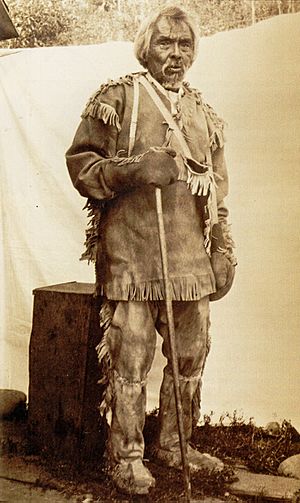Tahltan facts for kids

James Teit, Tahltan medical practitioner, c. 1932
|
|
| Regions with significant populations | |
|---|---|
| Canada (British Columbia) | |
| Languages | |
| English, Tahltan | |
| Religion | |
| Christianity, Animism | |
| Related ethnic groups | |
| Kaska, Tagish |
The Tahltan are a First Nations group from northern British Columbia, Canada. They speak a language from the Athabaskan family. You can find Tahltan communities near places like Telegraph Creek, Dease Lake, and Iskut. The Tahltan are also known as part of the Nahane people, which means 'People of the West'.
Contents
Discover Tahltan Culture and Traditions

Tahltan culture was rich and diverse. Their ways of life changed depending on where they lived. This was because their communities were often far apart. The Tahltan believed that some of their ancestors had special knowledge from before a big flood. Some ancestors used this knowledge to help their people. Others used it for selfish reasons. The Raven is seen as a hero in their stories. He often worked against those who used their knowledge for bad.
How Tahltan Society Was Organized
Tahltan society was based on a matriarchy. This means that family lines and leadership often passed through the mother's side. People from two main family groups, called clans, would marry each other. These two main clans are:
- Tses' Kiya (pronounced Tses-kee-ya), which means Crow.
- Chiyone (pronounced Chee-oanah), which means Wolf.
These two main clans were divided into four smaller groups or parties:
- Kartchottee (Raven)—This group came from the Interior, near the start of the Taku River. It is the largest group among the Tahltan. The frog also represents this family.
- Nanyiee (Wolf)—This group is also represented by the brown bear, the killer whale, and the shark. They started near the Taku River's headwaters. They moved towards the ocean and lived among the Stikine Tlingit people. Later, they moved up the Stikine River and became part of the Tahltan.
- Talarkoteen (Wolf)—This group came from near the Peace River in the Interior. They followed the Liard River to Dease Lake. Then they crossed over to the Tuya area.
- Tuckclarwaydee (Wolf)—This group is also represented by the brown bear, the eagle, and the killer whale. They are believed to be the first founders of the Tahltan tribe. They came from the interior, near the headwaters of the Nags river.
Tahltan Government Today
Today, the Tahltan people are organized as the Tahltan Nation. This includes members and leaders from the Tahltan First Nation and the Iskut First Nation.
A Look Back: Tahltan History
About ten thousand years ago, the Tahltan people used a special type of volcanic glass called obsidian. They got this obsidian from Mount Edziza. They used it to make tools and weapons. These items were also important for trading with other groups. Mount Edziza was the main place to find obsidian in northwestern British Columbia.
Protecting Sacred Lands: The Coal-bed Methane Conflict
Since 2005, a group of Tahltan elders called the Klabona Keepers have been protecting their land. They watch the road that leads through Tahltan territory. This road goes towards the Sacred Headwaters (Klappan Valley). The elders are against a coalbed methane mining project planned by Royal Dutch Shell in this area.
The Sacred Headwaters (Klappan Valley) is a very important place. It is where the headwaters of the Nass, Skeena, and Stikine Rivers begin. These rivers are home to many important salmon. Tahltan oral history says that these headwaters are where the earth was first created. It is also where Tahltan culture began. The Klabona Keepers say the valley is used for fishing, hunting, and trapping. It also has a Tahltan burial ground. There is a cultural camp where Tahltan youth learn about their culture in the summer.
In 2004, Shell was given rights to explore for oil and gas in the Klappan Valley. This valley has one of British Columbia's largest coal deposits. It is estimated to hold about 8 cubic kilometers of methane. That year, Shell drilled three test wells. But in 2005, a group of elders turned away four Shell employees. No drilling happened that summer.
Peaceful protests in 2005 and 2006 slowed down the development plans. Thirteen protesters were arrested. In 2006, half of all mining exploration in British Columbia happened in Tahltan territory. Protests in Smithers had as many as 600 people. Famous people like David Suzuki and Wade Davis have spoken against the mining plans. In June 2007, 14 environmental groups sent a letter to Shell opposing the project.
Shell representatives said they wanted to reach an agreement with the community. They noted that the elected Tahltan Central Council (TCC) had agreed to the exploration. However, Chief Jerry Asp had to resign in 2005. This happened after Tahltan members protested. They said he had a conflict of interest because he was involved with groups that supported development.
On December 18, 2012, the B.C. government announced good news. Shell would stop its plans to explore and drill for coalbed methane gas in Tahltan Territory. The Klabona Keepers have filed a counter-suit against Shell. They say Shell did not properly consult with them. Today, there are job opportunities from natural resource development. All groups involved try to balance development with protecting the environment.
Sometimes, there is talk about building an Alaska-Canada railroad. This railroad would go through Tahltan lands. Studies are done from time to time to see if it is possible.
Tahltan Language
The Tahltan language is a Northern Athabaskan language. It is not well documented. Some language experts believe Tahltan is one language with three different dialects. These dialects can be understood by speakers of each. Other experts think these are separate languages. Here are the approximate numbers of speakers:
- Kaska: about 400 speakers (2003)
- Tahltan: about 35 speakers (2003)
- Tagish: no fluent speakers as of 2008
See also



